
Kingdom’s tour of imaginary golf courses takes a new turn, as true to the majors theme in this issue we have assembled a layout of some of the greatest holes in the history of majors golf.
Each hole in our fantasy course remains true to its hole number within its home course and we have tried to create a scorecard with a yardage and total par that is as realistic as possible (although a quintet of par-5s on the back nine might leave some golfers calling for a cart). Honestly, the process has not been easy. It has induced headaches and heartburn, debate and despair. For every great hole included on these pages there are at least half a dozen classics denied. For most hole numbers it was more. Where do you even start with great 18th holes on major championship courses? It was a tough job but we had to do it. Here is Kingdom’s Majors 18.
Cherry Hills, Colorado
Par 4, 389 yards, Handicap 15
After 54 holes of the 1960 U.S. Open Arnold Palmer trailed by seven. As he sat in the clubhouse before the final round, Pittsburgh sportswriter Bob Drum laughed when Palmer spoke of winning. It was just the motivation he needed.
The downhill par-4 1st at Cherry Hills will forever be known as the launch pad for Palmer’s most dramatic comeback. Incensed that Drum doubted him, Palmer gave his opening shot of the final round everything he had, his tee shot rolled down onto the green, Palmer sunk the birdie putt and arguably the greatest final-round comeback in the history of the majors was off and running. Palmer would ultimately win by two.
Cherry Hills’ 1st has since been lengthened and is out of range for all but the most explosive of drivers, which would have been the intention of designer William Flynn back in 1922. We’re playing from the back tee, from where the whole course is in view. The main concerns are a tree-lined creek running down the right and a fairway bunker on the left. An accurate pitch to a small, sloping green with a swale across its middle is usually required to match Palmer’s three.
Kiawah Island (Ocean), South Carolina
Par 5, 528 yards, Handicap 8
Kiawah Island rose to immediate prominence when it staged the 1991 Ryder Cup, the “War on the Shore”. The American hosts won with drama on the last green, when Bernhard Langer missed a six-foot putt to retain the cup for Europe. The Pete Dye golf course was only half-baked in the fall of 1991, only just ready, but it produced a roasting Ryder Cup, and the PGA Championship duly followed to this stretch of Atlantic shoreline in 2012.
The 2nd hole on the Ocean Course is as challenging as it is beautiful. The first hurdle is to drive further than 175 yards in order to clear the marsh in front of the tee and reach the fairway. Always a carpet of impeccably groomed grass, the fairway will yield a second shot to the green from time to time, though the smart play is often to lay up short of the next belt of marsh that juts across the fairway, 110 yards short of the green. The pros play 543 yards of this hole but we are off the Ocean tee, a snip at 528.
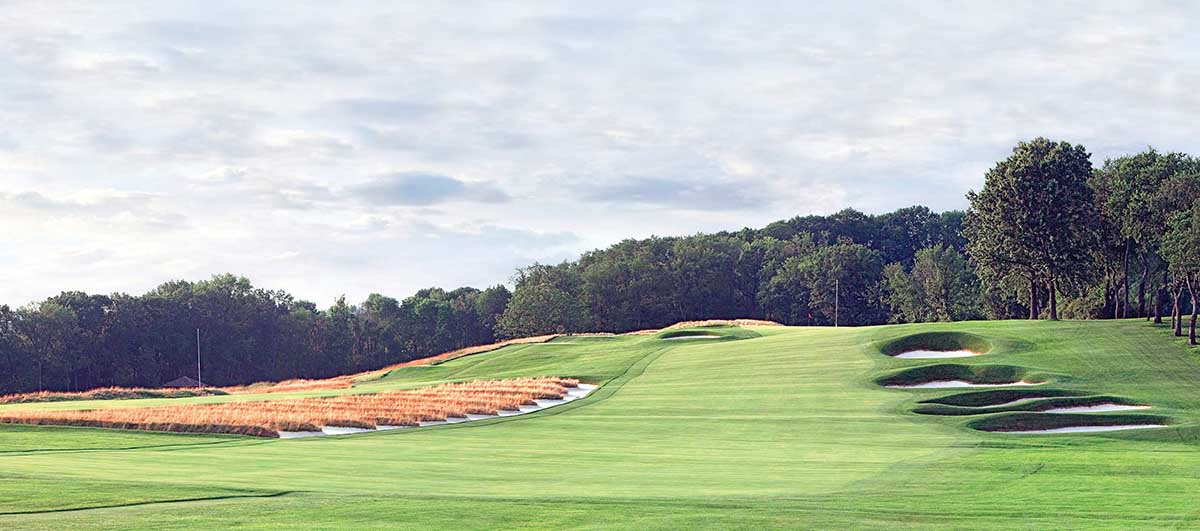
Oakmont, Pennsylvania
Par 4, 390 yards, Handicap 4
Welcome to one of the toughest tee shots on arguably the most demanding of all U.S. Open golf courses, 2016 venue Oakmont, outside Pittsburgh.
The famous Church Pews bunker occupies two acres of real estate down the left side of the fairway (it poses a similar threat on the returning 4th). For many golfers this is a place of worship, though Palmer might have dissented just after the photograph of him playing from the Church Pews during his final U.S. Open appearance in 1994 was taken. The Church Pews features 12 grass-covered ridges surrounded by sand, and often a sideways or backward chip is the only means of escape. A line of five forbidding traps down the right side offer no respite, although a straight drive could set up a relatively straightforward approach to an elevated green. However, a cluster of bunkers in front of the green—three right and two left—lie in wait.
The U.S. Open yardage here is 426 but we are inching forward to the blue tee at 390 yards. Stay straight.
Baltusrol (Lower), New Jersey
Par 3, 186 yards, Handicap 11
In preparation for the 1954 U.S. Open, Baltusrol’s famous Lower Course was modernized by Robert Trent Jones Sr. without detriment to A.J. Tillinghast’s initial design. The most significant changes came at the ‘Famous Fourth’, which was lengthened by nearly 70 yards and toughened by reshaping the bunkers behind a terraced green. Jones’s alterations created a full carry over Tillinghast’s original pond and replaced the wooden façade between green and hazard with a distinctive rock wall.
Today the 4th is viewed as Baltusrol’s signature hole but the members weren’t always so pleased with it. After criticism that he’d made the hole too difficult, Jones said: “Let’s go play it and see if anything needs to be done.” After head pro Johnny Farrell and two prominent members had all hit the green, Jones stepped onto the tee and holed-in-one. “Gentlemen, I think the hole is eminently fair,” he quipped.
Playing to 195 yards from the back in the 2016 PGA Championship, we are opting for the Tillinghast tee and a distance of 186 yards, to allow some players an extra club of loft.
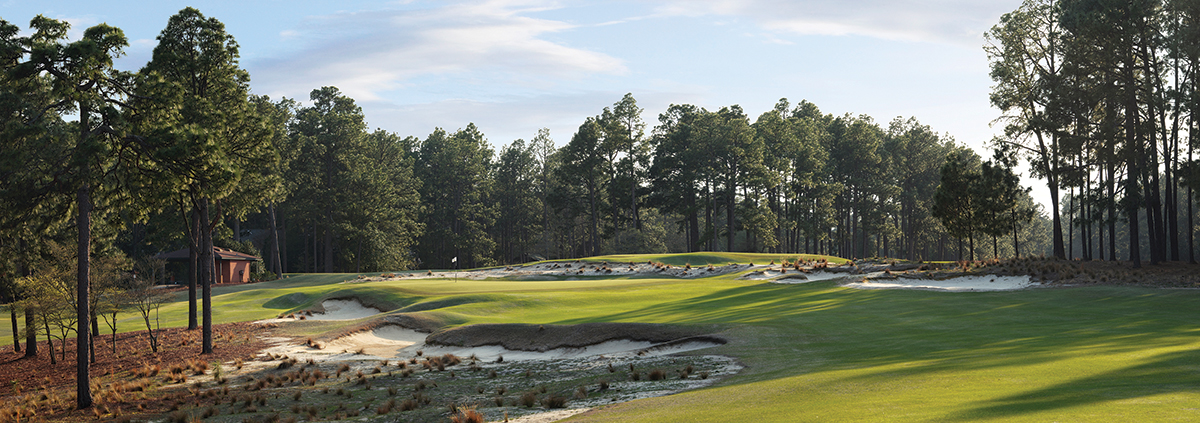
Pinehurst (No.2), North Carolina
Par 5, 508 yards, Handicap 10
Of Pinehurst’s eight courses, its jewel in the crown is unquestionably No.2, Donald Ross’s masterpiece. Tommy Armour summed it up: “The man who doesn’t feel emotionally stirred when he plays golf at Pinehurst beneath those clear blue skies and with the pine fragrance in his nostrils is one who should be ruled out of golf for life. It’s the kind of course that gets into the blood of an old trooper.”
The 5th, once a par-4 behemoth, has boiled many a competitor’s blood. It averaged a score of 4.4 in the 2005 U.S. Open before Ben Crenshaw and Bill Coore restored the course and lengthened the 5th into a more logical par-5. The predominant feature of No. 2’s raised greens is how difficult they are to hit and hold, even from pristine lies. The putting surface here, an upside-down bowl with curvaceous contours and slick as ceramic, is no exception.
The 5th played to a lengthy 576 yards for the 2014 U.S. Open, when Martin Kaymer played the golf of his life to win by eight, but we are heading to the Blue tee and a more inviting yardage of 508. No.2 will receive its fourth U.S. Open in 2024.
Carnoustie Golf Links, Scotland
Par 5, 578 yards, Handicap 5
Carnoustie can be bleak—the least visually appealing of The Open courses—and if you (right-handed) hook your drive off the 6th you will feel the full force of Carnoustie’s dark side. Nonetheless, this is a golf hole for the ages.
The longest hole on the course at 578 yards from the back and usually played into the prevailing wind, we are playing to a more sympathetic 520 but that might not help with the drive. A fence and out of bounds press from the left, while a pair of bunkers occupy the center ground to unnerve the straightest of drivers. The bold play is to a narrow runway between the fence and the bunkers, which Ben Hogan found masterfully in the third and fourth rounds of The Open in 1953. Hogan sent out his customary fading drives towards out of bounds before his ball eased into the ideal landing area. On both occasions he struck a four-wood approach and two-putted for two birdies and he won by four. The hole has since been known as “Hogan’s Alley”.
A burn angles in from the right, ahead of a green protected by four bunkers. Sandy Lyle, the Open champ of 1985, advised that par should always be the target here.
Pebble Beach Golf Links, California
Par 3, 109 yards, Handicap 18
One of the shortest holes in majors golf, the downhill 7th at Pebble Beach is also one of the greatest. Five U.S. Opens and a PGA Championship have been staged over this enchantingly rugged piece of Californian coastline, and we will play the 6th to the same 109 yards as the pros. Why wouldn’t you?
It might seem on the card that this hole is a breather after the rigors of Pebble’s long, cliff-top 6th but nothing could be further from the truth. Standing on the tee, the roar of the pounding surf and crashing waves of Monterey Bay behind and to the right of the tiniest of greens (only 24 feet wide and surrounded by five bunkers) is intimidating to say the least. Club selection is predicated by the strength of the wind so the objective is to knock down a short iron and keep the ball from ballooning. Aim at the middle of the green and keep your fingers crossed.
That is what Tom Kite did in the final round of the 1992 U.S. Open, in near gale force winds. His tee shot missed the green but Kite holed the chip and won his only major title.
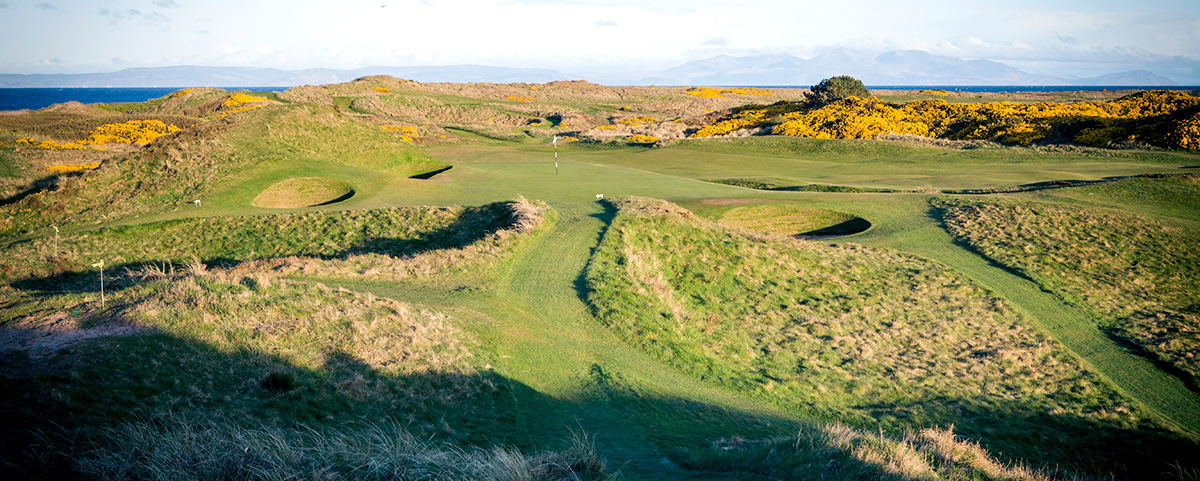
Royal Troon (Old), Scotland
Par 3, 123 yards, Handicap 17
Better known by its name than number, the tee on the diminutive “Postage Stamp” 8th on the Old Course at Royal Troon offers a superb view of Ailsa Craig in the Firth of Clyde. After a pretty long opening stretch to our fantasy 18 it is just a pity this hole follows the 7th at Pebble Beach, but that’s just how the divots fall. In fact, the R&A may set-up the Postage Stamp to play as short as 99 yards at the 2016 Open, depending on weather conditions. These are the two greatest very short holes in golf, so enjoy them.
The nickname was acquired in 1923 when Willie Park, Jr.—a winner of two Opens— wrote about a putting surface “skimmed down to the size of a Postage Stamp.” Another description aptly dubs it “the hardest stamp in the world to lick.” The raised tee looks across a gully to a narrow green set beside a large dune and two bunkers to the left. A crater-shaped bunker shields the approach while the right is guarded by two deep traps with vertical faces. There’s no safe option—the ball either finds the green or plummets into trouble. Aged 71, Gene Sarazen famously holed in one during the 1973 Open.
Royal Birkdale, England
Par 4, 400 yards, Handicap 2
This demanding links, famed for its magnificent sand dunes, was the scene of Arnold Palmer’s first victory in the [British] Open in 1961 and the club owns an Open heritage that stretches far beyond. It was here that Australian Peter Thomson won his first and fifth Open titles—in 1954 and 1965—and also where Tom Watson clinched his fifth and final Open triumph in 1983—his only Open win outside Scotland.
The 9th hole, a left-to-right dogleg, is a classic example of how tough the course can play. It plays to 410 yards in The Open and we are taking it on at 400 off the yellows. The blind tee shot needs to find the left half of the fairway although the wind often comes from the right and can blow the ball too far left into nasty rough. Before changes were made prior to the 2008 Open, many players took on the elbow but now, in all probability, such drives will fall into mounding and an uncertain fate. The putting surface is slightly elevated, thus placing a premium on club selection. Anything short is likely to be gathered by one of the two symmetrically placed bunkers at the front but there’s also plenty of trouble in the deep rough over the back.
Turnberry (Ailsa), Scotland
Par 5, 495 yards, Handicap 14
Links specialist Martin Ebert has just completed a stunning redesign of the Ailsa course at “Trump Turnberry”, to keep it a relevant Open challenge and capitalize on the rocky landscape along the shoreline of the Firth of Clyde. The 10th—once an excellent par-4—is now a breathtaking par-5.
If and when The Open returns the players will have to cope with a yardage of 562, but having just enjoyed refreshments at Turnberry’s lighthouse—now a halfway house—we are playing from the Whites at 495. The green has been pushed on to where the 11th tee used to be, perched above the cliff, and the hole’s famous doughnut bunker has been relocated and reshaped to now stand as a serious danger to golfers trying to reach in two.
Turnberry has hosted four Opens. The first was the legendary “Duel in the Sun” in 1977 when Tom Watson outlasted Jack Nicklaus by one, and its last was in 2009, when Watson—aged 59—came within a whisker of writing golf’s greatest story. But his 8-iron to the last inexplicably crept off the green, he dropped a shot to slip into a playoff and Stewart Cink won.
Augusta National, Georgia
Par 4, 400 yards, Handicap 3
It’s easier said than done, but if possible golfers should make their way to Augusta National at least once, and they will see that genuinely, Amen Corner is incomparable. There is striking beauty, vivid history, natural tranquility and the combination is intoxicating. So our Majors 18 takes it all in, entering via 11, pivoting on 12 and departing through 13.
The Masters yardage for the 11th—White Dogwood—reaches a forbidding 505 yards these days so we are heading to the Members tee at 400 yards, from where the challenge remains stern. The first rule is to stay out of the trees on the left, from where there can be no return, whereas if drives veer right there will always be some kind of second shot, even if it might be restricted by tree trunks and branches. When golfers reach the brow of the fairway they are entering Amen Corner, with the 11th green down to the left, the 12th hole ahead and beyond, the 13th tee.
Key to the approach is clearly to avoid the pond to the left of the green, just ask local boy Larry Mize. His approach fell right of the green in the playoff against Greg Norman to decide the 1987 Masters. Norman was on the green but Mize chipped in for birdie from 140 feet. Vivid history.

Augusta National, Georgia
Par 3, 155 yards, Handicap 16
The par-3 12th—Golden Bell—is the most famous par-3 in golf. It’s only 155 from the back so what could possibly go wrong? Well, Jordan Spieth has an idea. He was in control on the 2016 Masters with seven to play, he had led the Masters since the first round of 2015, but here he tried to force his will over Amen Corner, went for the right-hand pin perched precariously over Rae’s Creek and came up short. Calamity Corner. Six shots later and Spieth had posted a “quad” and the defence of his Masters title was sunk in the creek with two of his golf balls. Augusta is famous for the roars of the crowd rising from Amen Corner, but this time a collective gasp shuddered the pines.
Reflects Bernhard Langer, twice the Masters champion: “The green is angled from front-left to back-right and so is Rae’s Creek. Due to Amen Corner’s swirling winds I agree with Jack Nicklaus, in playing over the bunker even though the landing area is only about nine yards deep.”
Amen Corner can mess with you. Sometimes the flag on 11 can be flying one way while the flag on 12 goes another. Then you throw up some grass and find a third wind direction. Say a prayer, swing hard.
Augusta National, Georgia
Par 5, 510 yards, Handicap 13
From the most famous par-3 in golf to the most famous par-5—Azalea. The members play to 455 yards here but we are going to stick with the authentic Masters experience and go from the back at 510. It’s an elevated tee after all.
The fairway bends to the left with a tributary from Rae’s Creek as company the whole way, before the zigzagging waterway cuts in from the left-hand side and in front of the green. A draw from the tee is ideal as long as it stays above the creek, and a hanging lie for the second shot is less pronounced down the left side of the fairway.
This is a classic risk-and-reward par-5. Remember Phil Mickelson’s six-iron from 207 yards in the pine straw on the right? That was the final round in 2010. He holed the birdie putt and won his third Green Jacket by three.
There are rumblings about Augusta National buying land from neighboring Augusta Country Club in order to lengthen 13. The club will proceed with care and it must, here more than on any other hole.

Baltimore, Maryland
Par 5, 603 yards, Handicap 5
Founded in 1898, Baltimore Country Club is among the oldest golf clubs in the United States and its original Roland Park Golf Course—which is sadly no longer with us—was the first golf course in Maryland to hold a major championship, when the fifth U.S. Open was played there in 1899, won by Scotland’s Willie Smith.
The club’s current East Course at Five Farms in Timonium was designed by A.W. Tillinghast and opened in 1926, and it was widely lauded as superior to the original course from the outset. Like its predecessor, it did not take long for the Five Farms East course to gain major recognition, with the 1928 PGA Championship going there. Under the direction of Keith Foster, restoration of the East Course was completed last year.
The 14th is called ‘Hell’s Half Acre’, after an unkempt and unforgiving hilltop bunker complex that must be cleared by what would typically be a second shot. At 603 yards from the tips, this is a genuine three-shotter today.
PGA National (Champion), Florida
Par 3, 163 yards, Handicap 12
And to the “Bear Trap,” arguably the toughest three-hole stretch on the PGA TOUR. The Champion course at PGA National was originally designed by Tom & George Fazio and hosted the PGA Championship twice (1971 and 1987) before being reworked by Jack Nicklaus in 2014 and it is home to the Honda Classic. The Bear Trap incorporates holes 15, 16 and 17.
Wrote Karen Crouse of The New York Times: “The Champions layout at PGA National is 7,140 yards of venom, a king cobra of a course that rises without warning to strike down the world’s best golfers. Snake charmers may have a better chance of taming it.”
The par-3 15th is a slicer’s nightmare, with a lake dominating short of the green, to the right and long. Playing 176 yards on tour, and perhaps a club shorter on our card at 163 off the gold tee, a broad bunker awaits a pulled tee shot, although golfers are permitted a bail-out area, short and left. Says Nicklaus: “It’s about precision. It’s about guts.”
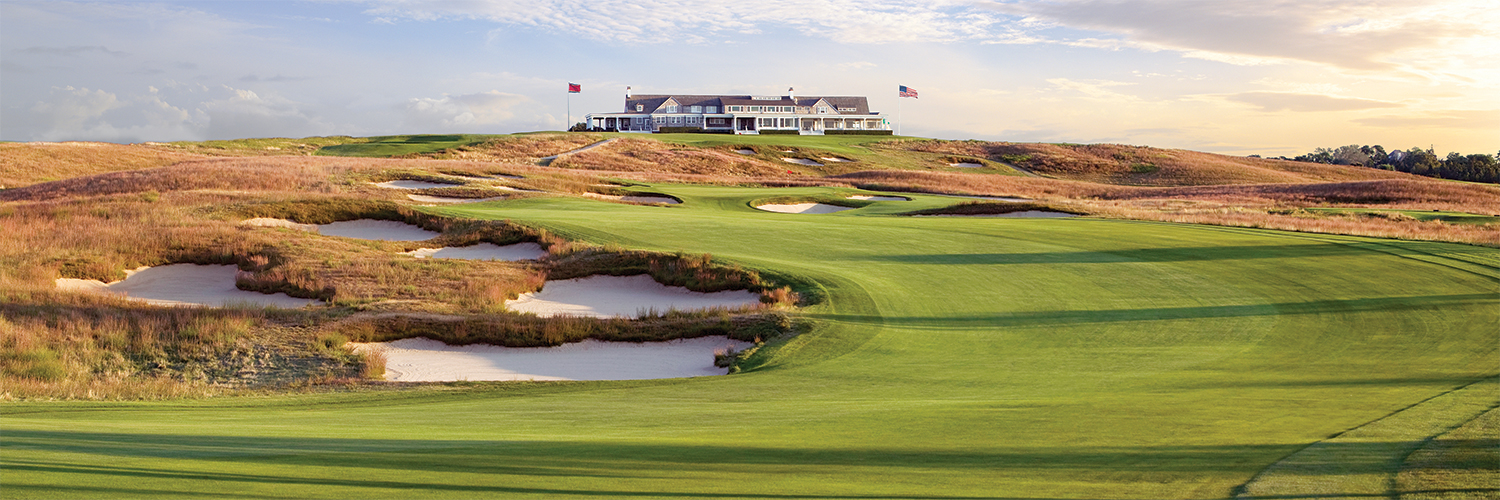
Shinnecock Hills, New York
Par 5, 542 yards, Handicap 7
Our golfing journey now heads north up the eastern seaboard of the United States to New York, and to a grandee of golf courses that regularly, inevitably features in our fantasy compilations, Shinnecock Hills. Founded in 1891, Shinnecock Hills was one of the five founding member clubs of the USGA and the original 12-hole course was built with the help of 150 Shinnecock Indians from a nearby reservation. The club hosted the second U.S. Open in 1896 and has held the event three times since, including its 100th anniversary in 1995, with the 2018 chapter also slated for the Long Island club.
The existing 18-hole championship course was designed by William Flynn and opened in 1931 and it occupies an exceptional parcel of land with Peconic Bay on one side and the Atlantic Ocean on the other. An open course over which winds frequently change direction—as do the holes—with over 150 bunkers Shinnecock is often likened to the finest British links.
The par-five 16th—called ‘Shinnecock’—runs to 542 yards from the back Red tee and in homage that is where we are heading, even if it means golfers toiling against Shinnecock’s prevailing wind. An ‘S’ shaped fairway is well protected by bunkers on both sides and by the thick golden meadow grass that can reach knee high. Rarely is par such a good score on a par-five of this yardage.
St. Andrews (Old), Scotland
Par 4, 436 yards, Handicap 1
And from one of the oldest courses in America to the oldest of them all—the mother ship—the Old Course at St Andrews, and to its famous 17th, the “Road Hole”. The Old Course is the spiritual home of golf and for The [British] Open, which has been played over the Old Course 29 times, far more than any other course. The clubhouse of the R&A sits like a throne behind the first tee, and while it would be too simplistic to describe the Road Hole as the signature hole of the Old Course, it is certainly the most distinct hole here. A brutal par four if played into the wind, with a glint in his eye Seve Ballesteros—Open champ on the Old Course in 1984—once described 17 as “the best par five in golf”.
A new tee extended the Road Hole to almost 500 yards in time for the 2010 Open, which only added to the sheer majesty and complexity of this incredible hole, although we are going off the Yellow tee at 436 yards, from which there remains plenty of golf hole to negotiate. It is the ultimate double-dogleg. Off the tee, the drive needs to be fashioned as a slight fade over the wall of the Old Course Hotel to hold the fairway; then a second shot shaped gently from right to left is the best route into a long, tantalizing green protected to the right by the eponymous road and its stone wall beyond. To the front left of the green lies the shadowy, sheer-faced bunker that has ruined more scores than any other bunker in golf.
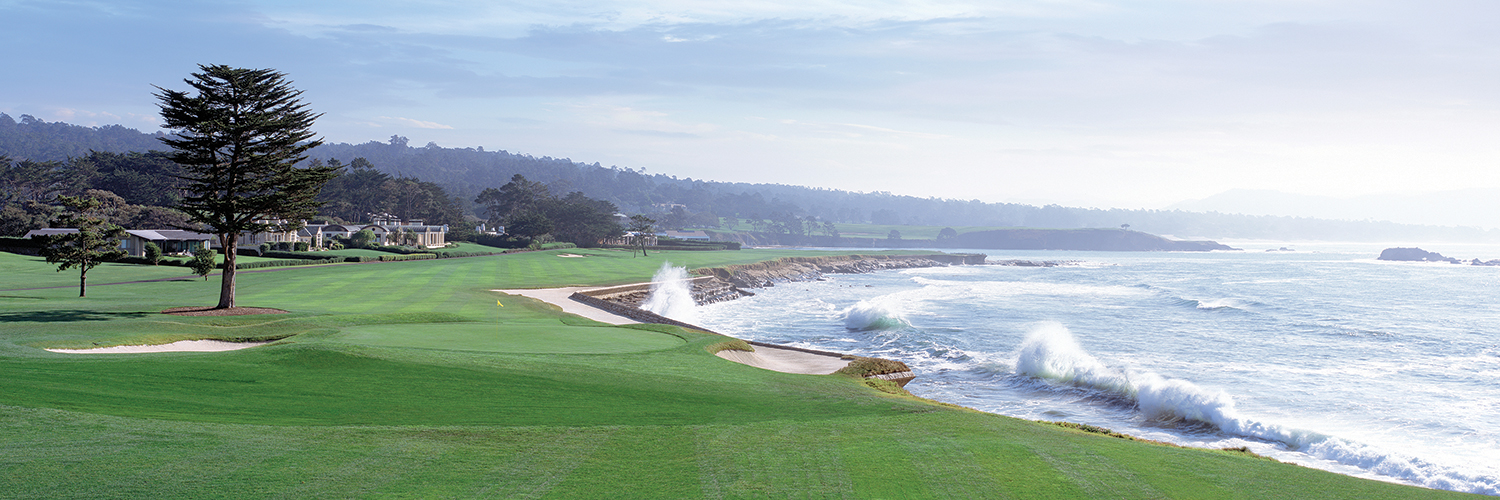
Pebble Beach, California
Par 5, 543 yards, Handicap 9
Pebble Beach, designed in 1918 by Jack Neville and Douglas Grant along an intoxicating stretch of cliff-top Pacific coastline, has become synonymous with the modern U.S. Open, having staged the national championship five times since 1972. That is why—with the exception of Augusta National—this is the only golf course we are visiting more than once in this 18 holes, and it is entirely fitting that we close our round at Pebble Beach’s remarkable 18th.
This golf course has established a track record for exacting standards, in terms of course preparation and in what it demands from golfers who take it on. Nowhere is this borne out more acutely than on the par-5 18th—for many pros still a genuine three-shotter—with the ocean a constant threat down the left. It measures 543 yards from the back and that is where we are playing from, to close out with an authentic U.S. Open experience. Take in the ocean vista, breathe in the sea air and then disregard it as you stand over the tee ball, and think only of delivering down a line that is left of the trees. The second shot should finish on the left half of the fairway to avoid the tree overhanging the green, while a short-iron approach must carry the front trap; then finally, remember that putts on 18 tend to fall towards the ocean.
Follow Us On


| Cookie | Duration | Description |
|---|---|---|
| cookielawinfo-checkbox-analytics | 11 months | This cookie is set by GDPR Cookie Consent plugin. The cookie is used to store the user consent for the cookies in the category "Analytics". |
| cookielawinfo-checkbox-functional | 11 months | The cookie is set by GDPR cookie consent to record the user consent for the cookies in the category "Functional". |
| cookielawinfo-checkbox-necessary | 11 months | This cookie is set by GDPR Cookie Consent plugin. The cookies is used to store the user consent for the cookies in the category "Necessary". |
| cookielawinfo-checkbox-others | 11 months | This cookie is set by GDPR Cookie Consent plugin. The cookie is used to store the user consent for the cookies in the category "Other. |
| cookielawinfo-checkbox-performance | 11 months | This cookie is set by GDPR Cookie Consent plugin. The cookie is used to store the user consent for the cookies in the category "Performance". |
| viewed_cookie_policy | 11 months | The cookie is set by the GDPR Cookie Consent plugin and is used to store whether or not user has consented to the use of cookies. It does not store any personal data. |